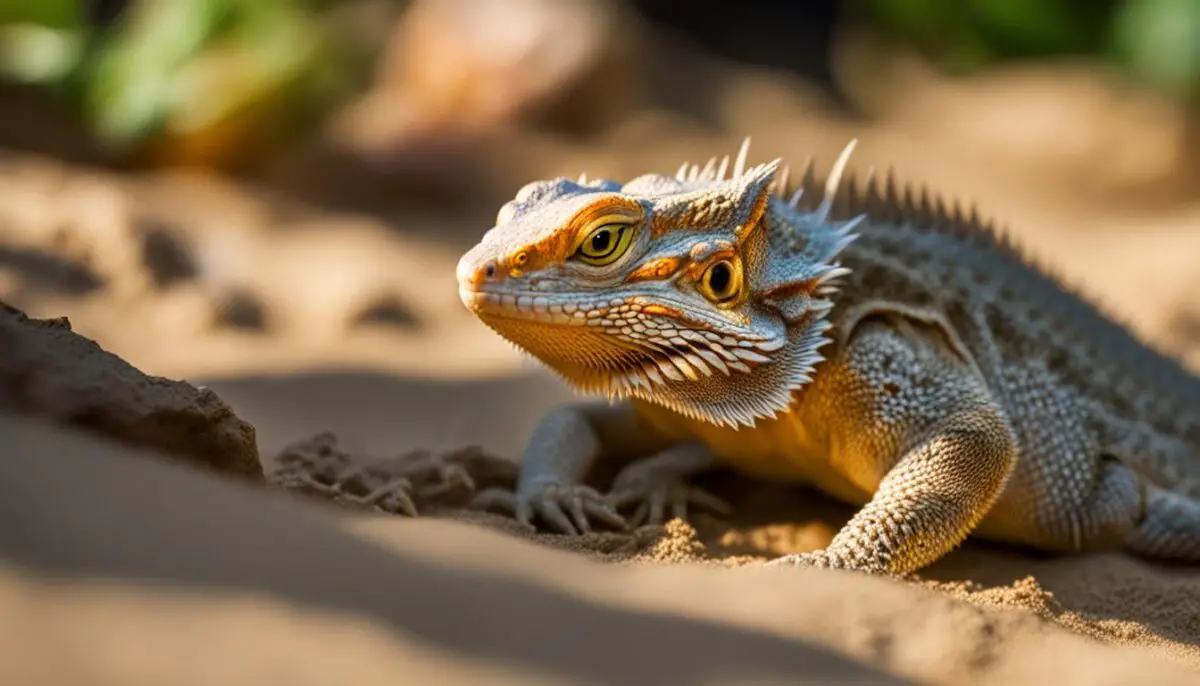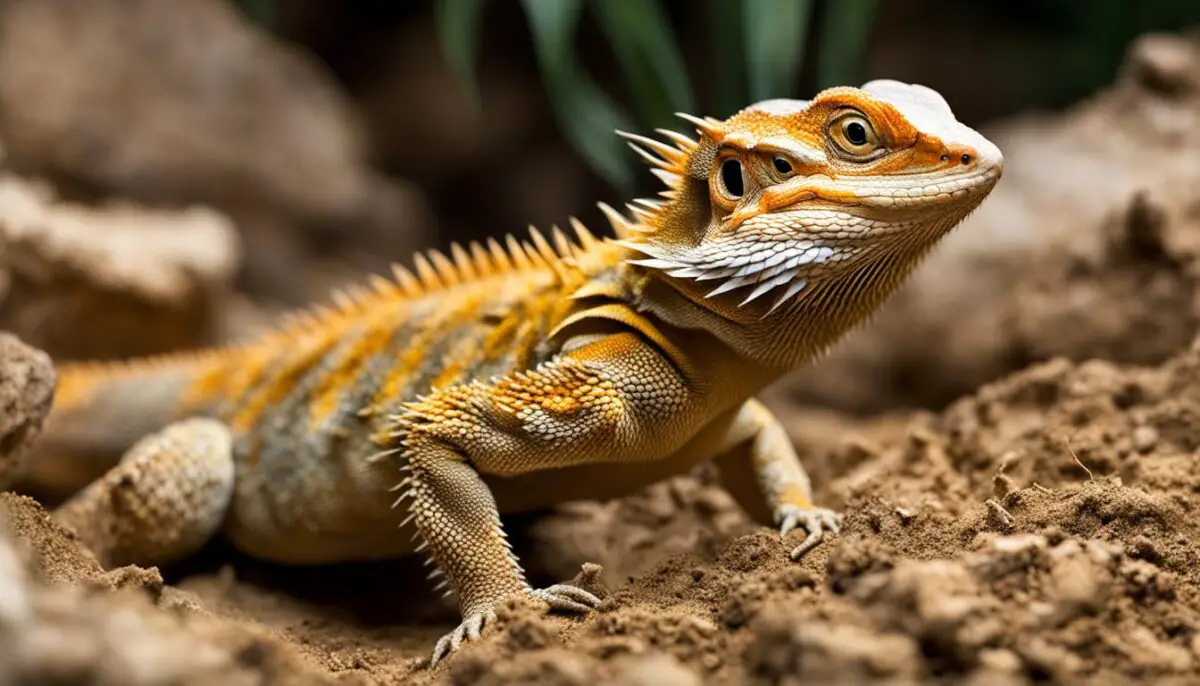Bearded dragons are fascinating reptiles that exhibit a wide range of behaviors, including digging. If you’ve ever wondered why your bearded dragon is digging or if it is normal behavior, this article is for you.
Digging is a natural instinct for bearded dragons and serves various purposes. One reason they dig is to create burrows for warmth and security. By burrowing, they can regulate their body temperature and escape extreme weather conditions. It’s their way of seeking comfort and safety in their environment.
Another reason for digging is to search for food or insects. Bearded dragons are opportunistic eaters and may dig to uncover hidden snacks. This behavior mimics their natural foraging instincts in the wild.
Additionally, female bearded dragons may dig when they are ready to lay eggs. This is a natural and crucial process for their reproductive cycle.
Understanding the reasons behind your bearded dragon’s digging habits is essential for their overall well-being. By recognizing their behaviors, you can provide appropriate care and attention to meet their needs.
Key Takeaways:
- Bearded dragons dig for various reasons, including warmth, food search, and reproductive needs.
- Digging is a natural instinct and serves important purposes for these reptiles.
- Recognizing and understanding your bearded dragon’s digging behavior is crucial for their well-being.
- Providing appropriate care and attention, such as suitable substrates and nesting areas, is essential.
- Monitoring their digging habits can help you identify potential issues or concerns.
Common Behaviors of Bearded Dragons
Bearded dragons, with their unique personalities, display a variety of behaviors that contribute to their overall well-being. Understanding these behaviors can help you ensure a healthy and happy life for your pet.
Here are some common behaviors exhibited by bearded dragons:
- Head bobbing: This behavior is often seen in males and is a way for them to assert dominance or attract a mate.
- Waving: Bearded dragons sometimes wave their arms to signal submission or as a friendly gesture.
- Color changes: Their skin color can change depending on their mood, temperature, or overall health.
- Basking: Bearded dragons love to soak up the heat and bask under their heat lamp or in the sun.
- Mouth gaping: This behavior helps regulate their body temperature and is a sign of a comfortable and relaxed bearded dragon.
- Tail curling: Bearded dragons curl their tails as a defensive mechanism or when they’re feeling threatened.
- Hiding: Providing hiding spots is essential as bearded dragons seek shelter to feel secure and safe.
One behavior that is particularly normal for bearded dragons is digging. Bearded dragons may dig in their substrates to create burrows or explore their environment.

As long as these behaviors are not excessive, prolonged, or accompanied by signs of illness, they are considered part of a healthy bearded dragon’s behavior.
Unusual Behaviors and Potential Issues
While certain behaviors are normal for bearded dragons, some behaviors may indicate potential issues or concerns. It’s important for bearded dragon owners to be aware of these unusual behaviors and take appropriate action to ensure the well-being of their pets.
Bearded Dragon Digging for Eggs:
If a female bearded dragon is digging excessively and shows signs of restlessness, it may be an indication that she is preparing to lay eggs. This natural behavior is known as gravid digging and usually occurs when a female bearded dragon is ready to lay her eggs. During this time, it is essential to provide her with a suitable nesting area in the enclosure.
Bearded Dragon Digging in Enclosure:
Excessive digging in the enclosure can be a sign of stress or boredom. Bearded dragons are curious creatures and need mental and physical stimulation to remain healthy and engaged. To prevent excessive digging, ensure that the enclosure is properly enriched with appropriate substrates, hiding spots, and activities.
Monitoring your bearded dragon’s behavior and providing the necessary care and attention can help address these unusual behaviors and potential issues.
| Behaviors | Potential Issues | Recommended Actions |
|---|---|---|
| Excessive digging | Gravid digging (female preparing to lay eggs) | Provide a suitable nesting area and monitor behavior |
| Excessive digging | Sign of stress or boredom | Enrich the enclosure with appropriate substrates, hiding spots, and activities |
By addressing these issues promptly and providing a healthy environment, you can ensure the well-being of your bearded dragon.

Addressing Digging Behavior
If you’re facing concerns or nuisance due to your bearded dragon’s digging behavior, there are effective methods to address it. By providing a suitable digging area with appropriate substrates, such as sand or soil, you can redirect their behavior and fulfill their natural instinct to dig. In addition, ensuring that the enclosure is adequately enriched with toys, climbing structures, and hiding spots can help alleviate boredom and minimize the need for excessive digging.
It’s important to note that digging is a natural behavior for bearded dragons, and completely stopping their digging behavior may be challenging. However, redirecting the behavior and providing alternative outlets can help strike a balance between your bearded dragon’s natural instincts and your concerns.
If you’re unsure about creating a suitable digging area or enriching the enclosure, consult with a reptile veterinarian or a knowledgeable reptile owner for guidance.
Remember, understanding and addressing your bearded dragon’s digging behavior is essential for their overall well-being and happiness.
Comparison of Different Substrates for Bearded Dragons
| Substrate | Pros | Cons |
|---|---|---|
| Sand | Allows natural digging behavior, easy to shape into burrows | Potential ingestion and impaction risk if ingested in large quantities |
| Soil | Safe for ingestion, mimics natural environment, retains moisture | May require frequent cleaning and monitoring for pests |
| Paper Towels | Easy to clean, low risk of impaction or ingestion | Does not provide natural digging experience |
| Reptile Carpet | Safe for ingestion, easy to clean and replace | May not stimulate natural digging behavior |
Conclusion
Bearded dragons have unique digging habits that serve various purposes in their natural behavior. Whether they are searching for food, creating burrows for security, or preparing to lay eggs, digging is an essential part of their instinctive behavior. As long as the digging is not excessive or accompanied by signs of illness, it is considered a normal behavior for these fascinating reptiles.
To ensure the well-being of your bearded dragon, it is crucial to understand and address their digging habits. Providing a suitable environment with appropriate substrates, such as sand or soil, allows them to fulfill their natural instincts and engage in their digging behaviors. Additionally, offering mental and physical stimulation through toys, climbing structures, and hiding spots helps prevent boredom and excessive digging.
By monitoring their digging habits and ensuring their enclosure is enriched and stimulating, you can create a healthy and happy environment for your bearded dragon. Remember, allowing them to express their natural behaviors, including digging in a suitable substrate, is a way to promote their overall welfare and ensure they thrive as beloved pets.
FAQ
Why is my bearded dragon digging?
Bearded dragons may dig for several reasons, including creating a burrow for warmth and security, searching for food or insects, attempting to lay eggs, or exhibiting natural instinctive behavior.
What are the signs of a healthy bearded dragon?
Signs of a healthy bearded dragon include normal digging behavior in the substrate, along with other behaviors such as head bobbing, waving, color changes, basking, mouth gaping, tail curling, and hiding.
Should I be concerned if my female bearded dragon is digging excessively?
If your female bearded dragon is digging excessively and shows signs of restlessness, she may be preparing to lay eggs. Providing a suitable nesting area and monitoring her behavior is essential during this time.
What does excessive digging in the enclosure indicate?
Excessive digging in the enclosure may be a sign of stress or boredom. Bearded dragons should have an enriched environment with appropriate substrates, hiding spots, and activities to keep them stimulated and engaged.
How can I address my bearded dragon’s digging behavior?
Providing a suitable digging area with appropriate substrates, such as sand or soil, can redirect the behavior and fulfill their natural instinct to dig. Additionally, ensuring that the enclosure is enriched with toys, climbing structures, and hiding spots can help alleviate boredom and minimize the need for excessive digging.
Can I completely stop my bearded dragon from digging?
While it may be challenging to completely stop a bearded dragon’s digging behavior, providing appropriate outlets for their natural instincts and needs can help redirect the behavior and minimize the need for excessive digging.


